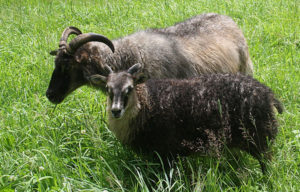Using the Barn/Jug system of lambing … and why it works for us
This April of 2016 will be our 20th lambing here at Frelsi Farm. Our first lambing produced 13 lambs and our total live lambs born here so far is now 905. We have used the barn and jug system of lambing each year. Our ewes have 24 hour a day access to the barn from breeding season through lambing. In most years, weather and snow permitting, they can be outside when ever they want, in fenced paddocks each about a ¼- ½ acre in area. The paddocks are protected by electro-net and plastic deer mesh fence inside the high tensile perimeter fencing. Inside the barn is a heated water tank and the feeders, outside are the mineral salt/kelp meal feeders.
We separate the ewe lambs from the adults and yearlings, to allow the ewe lambs to have all the feed they want and not be pushed aside by the big girls. The set up will vary depending on the number of ewe lambs and adults/yearlings. The water tank is available to both groups of ewes. We have found that they drink far more water if it is warm and available 24 hours a day (and I hate dealing with frozen water buckets). Our barn has an open southern exposure with woven wire doors, and the northern side has woven wire doors, inside sliding wooden doors. The siding on the barn was going to be board and batten, but we did not get the battens on before winter our first year. We found that the air that moved through the barn through those ¼- ½ inch spaces between the boards was actually good, keeping the air quality good and keeping the moisture down, so we have left it like that. There are large windows on the east and west sides so the barn is light and pleasant inside. The floor is packed dirt and reprocessed (ground up ) concrete. The waste hay is bedding with added straw as needed.

Before lambing, the barn is completely cleaned out and the manure and hay is composted, so that the lambs are born in clean areas.As lambing becomes imminent, we assemble “Jugs” in the barn. We built a warm room, a heated insulated space, in the southwest corner of the barn. Along that wall, inside the barn area, we build 3 jugs, each about 4×5-6 feet. We use Premier panels or cattle panels cut to length, tied together with bailing twine or wire.two panels “hinged” together this way are easy to store and move. They set up along the wall like letter “L”,each jug sharing one side, ie, LLL, the final side is a corner of the barn or another panel.If the ewes are bothered by the other family wil put a piece of ply wood between the jugs. You do not want the lamb sticking it’s head through the panel and getting bopped by the other mother! We add more jugs as needed along the other walls. When we did LAI (laparoscopic artificial insemination) we needed more jugs because many adults would be lambing in a 2-3 day period. With the VAI (vaginal artificial insemination)and natural breeding, the lambing is spread out more evenly over a few weeks, so fewer jugs re needed. Each jug has a hay feeder, a water bucket, and clean deep bedding. The jugs are cleaned and limed and re-bedded between families. Our ewes decide where to have their lambs. About 80-90 % choose to have their lambs in a protected area inside the barn. If it is nice weather, there seems to be more lambing out in the grassy areas of the paddocks, closer to the 20% figure. In a cold rainy spring it is closer to 1 in 10. Our pastures are so full of rocks and boulders, it would be impossible to find the ewes and newborns if they were to lamb out in the pastures. And, I like the hands-on lambing, watching the lambs being born and pampering mom for a little while. The ewes are moved from the birthing area to a clean jug. I just pick up the lambs and holding them in front of me, walk backwards to the jug and mom follows along. Most of the time, if I walk slowly and hold the lambs close to the ground, mom comes right along. Once in the jug, mom gets a few flakes of our best hay and a bucket of warm water with Karo syrup or molasses added for quick energy. The lambs are weighed and the navels are clipped and dipped, and they get a few squirts of “Baby Lamb Strength”, we call it candy. It is a Pipestone nutritional supplement similar to “Nutri-Drench”. We make sure each lamb gets a good bellyful of colostrum, check mom’s udder, and, if all is well, leave the family to rest and bond. An experienced ewe with twins may spend just a few hours in a jug if all is well and the space is needed, but usually has at least 24 hours to rest and eat and drink in peace. Triplets get a longer time, so that I can be sure all are getting enough milk, especially if one is smaller than the siblings. First time moms get at least a day and, preferably, two or three. I want to see that the lambs are nursing well, that mom is accepting all the lambs and that she has passed her placenta. Within the first 24 hours, the lambs get BO-SE and Vitamin E injections and an ear tag. Mom gets a dose of dewormer . When that is done the family moves to a “Mothering –on pen” or nursery. She will stay in this larger area for a few days, get her hooves trimmed if needed, then out to the pasture behind the barn. This intermediate pen is good for the first-timers, they get to have the lambs running around and yet they are still contained. I check the udders daily and watch the lambs for any signs of being under-fed or out of sorts.When the ewes are in labor, I will often watch from the loft stairs or from the hayloft. I like to be around for the births, not because I have to be, just because I really like to be there. It is thrilling to see the lambs being born. Our warm room is very cozy and I have been known to there at night on the cot, with a few good books and a radio during the peak of lambing time. I found that putting a few red light bulbs in the barn lets me do a barn check at night without disturbing anyone. In the warm room I have my “lambing kit” and a few buckets of warm water. We have had a very low lamb mortality rate. I like not being out in the elements, April can be very cold and rainy and even snowy here…no fun trying to find moms and lambs in between the incredible number of rocks and boulders. The ewes seem to like to lamb in the barn, they choose it most often. I like “hands-on” lambing, it suits my nature. Our flock is small enough to know each ewe well, and being there for the birth of her lambs feels right to me. There is no right or wrong way to manage your lambing. It is important to be comfortable with what you choose and to make your decisions based on what works best for you and your flock. Best wishes for a great lambing season!
![]()


